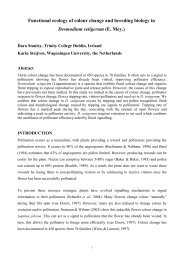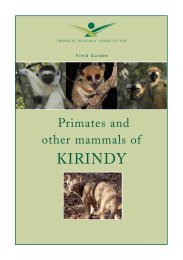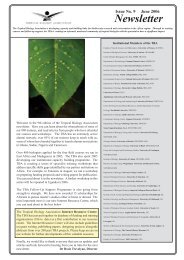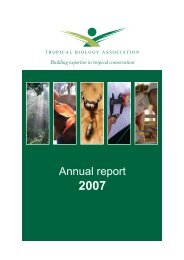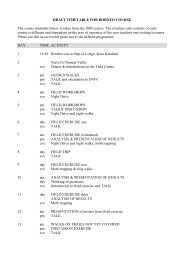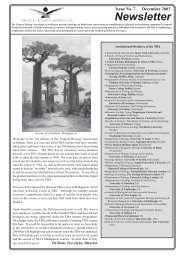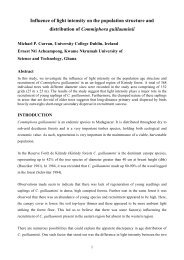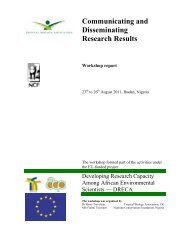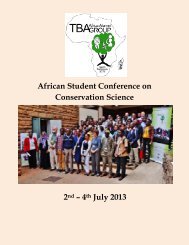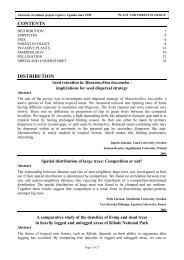Download TAAG Book of Abstracts - Tropical Biology Association
Download TAAG Book of Abstracts - Tropical Biology Association
Download TAAG Book of Abstracts - Tropical Biology Association
You also want an ePaper? Increase the reach of your titles
YUMPU automatically turns print PDFs into web optimized ePapers that Google loves.
Conserving the Endemic Birds <strong>of</strong> the Upper Guinea<br />
Forest under Current and Future Climates<br />
*Christopher Ilori and Deborah Ogunsola<br />
University <strong>of</strong> Greenwich, UK and Apple Tree<br />
International College, The Gambia<br />
*Email for correspondence:<br />
christopherilori@yahoo.co.uk<br />
Abstract<br />
That the World is currently experiencing biodiversity<br />
loss as a result <strong>of</strong> land-use and climate change is no<br />
longer a debate. These changes, whether in isolation or<br />
in combination, will have an impact on the distributions<br />
<strong>of</strong> species. Given this, it is becoming increasingly<br />
important to assess the distributions <strong>of</strong> species across<br />
landscapes. This study aims to produce habitat<br />
suitability maps for current and future distributions <strong>of</strong><br />
the endemic bird species in the Upper Guinea forest <strong>of</strong><br />
West Africa using GIS and a predictive species<br />
distribution model. For current distributions, data<br />
spanning 50 years (1950 – 2000) were obtained from<br />
WorldClim’s data portal. Models were developed for<br />
future distributions from the Intergovernmental Panel<br />
for Climate Change’s HadCM3 climate model for 2 time<br />
steps (2020 and 2050). Environmental layers were also<br />
used to examine the effects <strong>of</strong> different relevant<br />
predictors. The study revealed that vegetation was the<br />
most important determining variable for bird<br />
distributions in the Upper Guinea forest. It was also<br />
found that precipitation-based variables played more<br />
significant role than temperature-based variables for<br />
most <strong>of</strong> the modelled species. Realized and fundamental<br />
niches can be identified for species relocation to<br />
minimise biodiversity loss. Human disturbances will<br />
continue to lead to the destruction <strong>of</strong> vegetation cover,<br />
which currently serves as the major distribution<br />
determinant for the majority <strong>of</strong> the bird species, future<br />
modelling should therefore be enhanced by including<br />
vegetation projection.<br />
Keywords: Species distribution model, Upper Guinea<br />
forest, biodiversity loss, species relocation, climate<br />
model<br />
Understanding the variation <strong>of</strong> tree growth in an<br />
African mountain forest<br />
Badru Mugerwa 1 *, Douglas Sheil 1, 2,3 and Julius Bunny<br />
Lejju 4<br />
1 Institute <strong>of</strong> <strong>Tropical</strong> Forest Conservation, Mbarara University<br />
<strong>of</strong> Science and Technology, P.O. Box 44, Kabale, Uganda<br />
2 School <strong>of</strong> Environment, Science and Engineering, Southern<br />
Cross University, P.O. Box 157, Lismore NSW 2480, Australia.<br />
3<br />
Centre for International Forestry Research, P.O. Box 0113<br />
BOCBD, Bogor 16000, Indonesia<br />
4 Department <strong>of</strong> <strong>Biology</strong>, Mbarara University <strong>of</strong> Science and<br />
Technology, P.O. Box 1410 Mbarara, Uganda<br />
*Email for correspondence:mugerwa@itfc.org or<br />
b.mugerwa@gmail.com<br />
Abstract<br />
A strong negative relationship between climate change and<br />
tropical forest growth has been reported. However, models<br />
for predicting the responses <strong>of</strong> tropical forests’ growth to<br />
climatic changes rarely consider the relationships between<br />
the local site characteristics and tree growth. We examined<br />
the variation <strong>of</strong> tree growth rates in Bwindi Impenetrable<br />
National Park. We attempted to understand and explain<br />
the relationships between tree growth and thirteen<br />
site/tree characteristics. We used a three-year growth data<br />
set for 3067 trees and tree ferns belonging to 99 species<br />
from six 1-ha permanent sample plots (PSPs). All stems<br />
measured ≥10 cm diameter at breast height. Tree growth<br />
rates varied significantly among PSPs. Average tree growth<br />
rate was 0.29cm/yr. Single factor general linear models<br />
(GLM) with a Gaussian error distribution and identity link<br />
identified species as the best predictor <strong>of</strong> tree growth<br />
among the considered predictor variables. A significant<br />
positive variation <strong>of</strong> tree growth among species, tree size<br />
classes, slope position, crown form, crown position, climber<br />
infestation and tree diameter was observed. On the other<br />
hand, tree growth varied significantly negatively with forest<br />
undergrowth, past human disturbance, competition for<br />
light, competition for all growth resources and altitude.<br />
Surprisingly, tree growth did not show a significant<br />
relationship with tree basal area. GLMs further<br />
demonstrated that a significant negative interaction<br />
between species, competition for light and altitude best<br />
explained variation <strong>of</strong> tree growth. This means that as<br />
altitude increases, competition for light also increases<br />
leading to reduced tree growth. Tree growth rates were<br />
significantly associated with both tree and local site<br />
characteristics. Our results suggest that these should be<br />
considered in managing tropical rainforest’s growth to<br />
mitigate climate change impacts through REDD+ and other<br />
mechanisms. Local tree/site characteristics should also be<br />
incorporated in models for predicting the responses <strong>of</strong><br />
tropical forests to climatic changes.<br />
Keywords: Bwindi, climate change, forest productivity,<br />
REDD+, tree growth, local forest and site characteristics.<br />
<strong>TAAG</strong> First African Student’s Conference, Nairobi. 2-4 July, 2013 17




